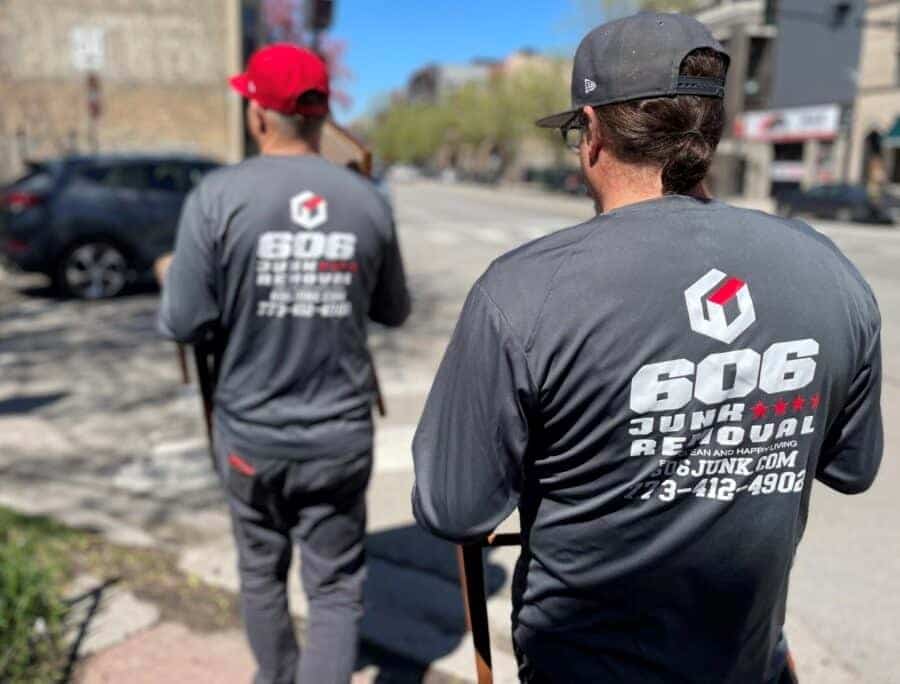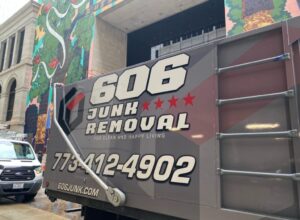
Before any massive bin rolls onto your property, pause for a moment and let your eyes assess the terrain. It’s tempting to assume that space equals readiness, but that’s a flawed assumption many Chicago residents make. Concrete isn’t always level, gravel can become unstable, and even grass can buckle under the weight of a dumpster’s steel frame. Survey your driveway or preferred placement site, not just for size but for slope, structure, and any sneaky overhead wires waiting to complicate matters.
Once that’s done, shift focus to access. Trucks delivering dumpsters don’t gracefully squeeze through narrow spots like compact cars. Think clearance. Think turn radius. Even that towering elm or that decorative post light might need to be factored into your planning. Preparing your space isn’t just preparation—it’s a safeguard against chaos.
Choosing the Right Dumpster Size Matters More Than You Think

10-Yard Dumpster
A 10-yard dumpster is perfect for small-scale cleanouts, like clearing out an attic, basement, or single bedroom. It holds about three pickup truck loads of debris, making it ideal for minor remodeling projects. In Chicago, it’s a great fit for tight spaces like alleys or compact driveways, especially in neighborhoods with limited room for oversized equipment.
15-Yard Dumpster
If your project falls between small and moderate, the 15-yard dumpster is your go-to. It’s ideal for garage cleanouts, small kitchen renovations, or removing carpet and flooring from a few rooms. This size is still compact enough to maneuver through most city streets, offering enough volume without taking up too much valuable space in urban areas.
20-Yard Dumpster
The 20-yard dumpster is a versatile option and one of the most popular choices for residential projects. It’s perfect for large furniture disposal, moderate renovations, or roof replacements. Holding roughly six pickup truck loads, it provides ample space without being oversized—especially useful for Chicago properties undergoing significant updates like Wicker Park remodels or Logan Square cleanouts.
30-Yard Dumpster
When you’re tackling a whole-home cleanout or a major renovation, a 30-yard dumpster delivers the space you need. It handles bulky items like old appliances, furniture, and construction debris with ease. This size is often used for flipping houses or gut renovations where waste accumulates fast. Just ensure your property or street can accommodate its footprint.
40-Yard Dumpster
The 40-yard dumpster is the heavyweight champion of waste containers, designed for large-scale commercial or demolition projects. With enough room for about 12 pickup truck loads of debris, it’s best used when you’re dealing with major structural teardown or multiple rooms of construction waste. It’s efficient—but only when you have the space to place and load it properly.
Check City Regulations and Neighborhood Rules Before Scheduling
Chicago, for all its grit and rhythm, doesn’t play fast and loose with municipal regulations. Every block seems to hum with its own tempo, and the rules shift slightly depending on where that dumpster is set to land. You can’t just plop a metal container on the street and call it a day. Permits are often required, especially for alley or curbside placements, and failure to comply could lead to fines that sting deeper than a cold Lake Michigan wind.
Then there’s the unwritten stuff—HOA quirks, block club preferences, or neighbors with itchy complaint fingers. A heads-up conversation can go a long way. Give notice, ask questions, and be sure to triple-check that your delivery won’t conflict with street sweeping, garbage day, or that upcoming neighborhood 5K. Strategy beats spontaneity every time.
Think About What You’ll Be Tossing and What You Shouldn’t
Not all trash is created equal, and not everything belongs in a dumpster. It’s tempting to think of these bins as black holes for your unwanted debris, but even Chicago’s dumpster ecosystem has boundaries. Hazardous materials like chemicals, tires, and paint cans are on the forbidden list for a reason—they’re environmental nightmares waiting to happen and will turn a routine drop-off into a major problem.
Before your cleanup even begins, create an inventory of what’s getting dumped. Old mattresses? Sure. Broken cabinets? Absolutely. Gasoline-soaked rags? Definitely not. If it feels flammable, corrosive, or toxic, assume it doesn’t belong. Get clarification where needed, and don’t wing it—one wrong toss can derail your project and lead to fines, delays, or worse.
Prepare the Drop Zone Like You’re Hosting a Steel Guest
Dumpsters are not dainty. When they arrive, it’s not with subtlety but with thunderous precision. That steel beast will sit exactly where it’s told, but the site better be ready. Laying down plywood or boards to protect your concrete or pavers is more than thoughtful—it’s wise. The pressure from the container’s corners can crack, scratch, or permanently scar surfaces.
Sweep the area. Remove low-hanging branches. Double-check your vehicle clearance. Think ahead to pick up the day too—access must remain clear from start to finish. If snow’s in the forecast, consider salting. If it’s leaves, rake them up. Your site becomes a stage, and the dumpster is center spotlight. A little prep avoids a lot of regret.
Timing Isn’t Everything But It Sure Comes Close
You’ve cleared space, picked your size, and scheduled delivery. Now, the question becomes: when? Timing is one of those underestimated pieces that can either streamline your project or gum up the works. If your cleanup effort spans days or weeks, don’t have your dumpster delivered too early or too late. The goal is synergy—alignment between your labor force, the weather, and the junk itself.
Weekends can mean trickier scheduling windows and higher demand. Rainy days make for soggy loads and sludgy pathways. If your work relies on daylight, aim for a morning delivery. If you’re in a downtown loop high-rise alley, traffic patterns will determine your best drop-off slot. The right time doesn’t just make things easier—it sharpens your entire operation.
Consider Parking and Traffic During Delivery and Pickup
Dumpsters arrive via trucks, and trucks need room. Not just any space will do—Chicago’s narrow alleys, dense neighborhoods, and one-way streets require logistical foresight. Delivery day should not come with honking neighbors or blocking fire lanes. If your location lacks adequate maneuvering room, you’ll need to clear additional space or rethink your positioning altogether.
Move cars out of driveways. Temporarily take off curbside zones with cones or chairs if allowed. Inform nearby residents of the delivery window, especially if street parking is already tight. A blocked truck means a rescheduled delivery, and that’s not something most projects can afford. Treat the arrival like a delicate ballet—because even steel trucks need choreography.
Think Ahead About Loading Strategy Not Just What You Load
Filling a dumpster isn’t like cramming a suitcase—it’s a layered operation that rewards forethought. Heavy items go in first, spread evenly to keep the load balanced. Odd-shaped objects? Tuck them into corners. Longboards or pipes should run lengthwise, not diagonally, to conserve volume. Chicagoans know space is a commodity, and efficiency matters when it comes to bulky waste.
Even your loading timeline should be deliberate. Will you be doing it all in one day or trickling in junk over a week? Stack with the end in mind—what’s going on last should be least valuable or most likely to shift. Secure lighter items if it’s windy. An unbalanced or poorly packed load can lead to overages, safety issues, or delays in pickup.
Don’t Overfill Even If It Looks Like You’ve Got Room
There’s a reason dumpsters come with clearly marked fill lines—and ignoring them can come back to bite you. An overfilled container isn’t just unsightly, it’s a liability. Items that stick out can fall during transport, damage nearby property, or create safety hazards. In Chicago, overages can also mean extra fees and delays, especially if the hauler refuses to pick up a non-compliant load.
Resist the temptation to squeeze in just one more item. Flatten boxes, break down bulky items, and organize your debris with discipline. If you’re nearing capacity, reassess whether another dumpster might be the safer route. The illusion of space is a trap—don’t fall for it. Stay beneath the rim, and your project will close smoother than it started.
Sweep Before Pickup Is More Than Just Clean-Up
When the last nail has dropped and the final scrap gets tossed, don’t collapse on the couch just yet. A thorough site sweep before pickup ensures nothing critical gets left behind—physically or administratively. Double-check the surrounding area for tools, leftover debris, or any accidental “keepers” that might have ended up in the bin during the hustle of cleanup.
Make sure the path is still clear for the truck to retrieve the dumpster. Don’t let parked cars or construction gear block the exit route. A forgotten bag of trash near the edge or a stray chunk of drywall can mean cleanup fees or a failed pickup attempt. Closing out right is just as essential as prepping correctly. Treat it like the final scene in a well-directed play.
Conclusion
Preparing for a dumpster delivery in Chicago is part science, part strategy, and all about awareness. From selecting the right size container to making sure your drop-off location is clear and compliant with local guidelines, every detail matters. Think ahead—will your driveway support the weight? Is the street wide enough for the truck? Are there overhead wires or tree branches in the way? Whether you’re decluttering a garage, tackling a kitchen remodel, or handling an estate cleanout, a little planning goes a long way. Proper prep ensures smooth delivery, safe loading, and stress-free pickup.
For reliable, local service with a focus on customer care and efficient logistics, contact 606 Junk Removal and Dumpster Rental. Based in Chicago, IL, they’re available at 773-412-4902 or by email at info@606junk.com to help you get it done right.
